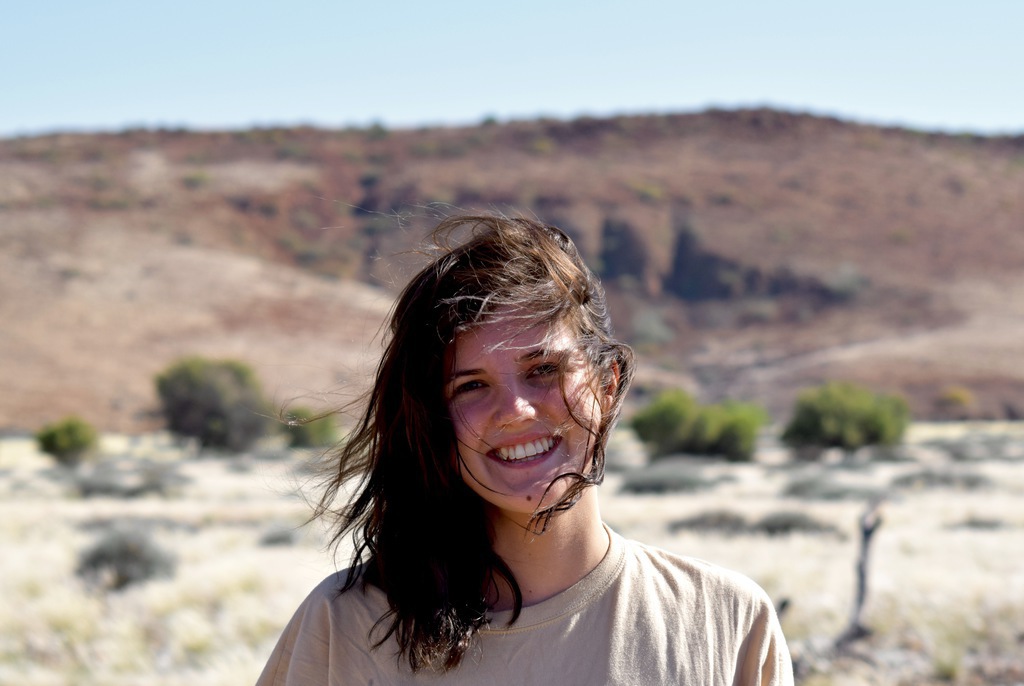As the 11th lucky Michael Hearn Intern, in May 2017 I packed up the world’s heaviest backpack (unsure of the etiquette re. rhinos seeing you in the same outfit twice) and set off on the trip of a lifetime to Namibia to spend a month with Save the Rhino Trust, where Michael Hearn had previously been Director of Research.
After two days adjusting to the coastal fog of Swakopmund, I stocked up on canned and dried food, and headed up North with Simson (CEO of SRT) to Mai Go Ha, the SRT field office in the Kunene region. The base camp at Mai Go Ha is where Simson spends the majority of his time, overseeing all operations on the ground. The only time Simson’s phone stops ringing is when he is so far into the bush that his phone can’t receive signal – some welcome silence for the busiest man I’ve ever seen!

I spent most of my time in the field under either the wing of Simson or Sebulon (SRT’s Principal Tracker). On my first day Sebulon and I set off into the bush to deliver a drum of water to rangers out in the field. The rangers and trackers have dedicated their life to the protection of this species, as they spend 21 days at a time out in the field tracking rhino by foot, with limited contact to the outside world. All rangers in the field are accompanied by law enforcement officers to ensure their safety. As a team they cover a remote and rugged area of 25,000km2.
The vast majority of the SRT team grew up in the local area and have worked at SRT for many years. Simson joined the team in 1991, holding several positions and working alongside Mike Hearn, before his appointment as CEO in 2014. Lesley, presently Director of Field Operations, started as an access control guard for SRT in 1993 before working his way up through the ranks to his current position, accumulating vast expertise across the field.
![]()
In addition to the trackers and management team, I spent a lot of my spare time with the people at the heart of the base camp; Welhemina, the office clerk, Angelyn, the office manager and cleaner (Angelyn is even lucky enough to have a rhino named in her honour!), and the children of some of the trackers. The SRT team at Mai Go Ha operate as a family and I was overwhelmed by the sense of common purpose. Whilst speaking to different members of staff about their reasons for working in rhino conservation there was a common theme – they want to protect rhinos for their children, their grandchildren and future generations.










Dear Anaban
Many thanks for your comments. To answer your questions:
1. When we send members of staff out to visit field programmes, they go with a list of tasks / outputs to achieve. In the case of this visit by Rosie to Save the Rhino Trust in Namibia, that included, for example, helping the Fundraising Manager at SRT with grant reports and grant applications that were being managed by us, passing on informal training about how we use social media, helping with office admin and other tasks delegated by SRT’s staff, as well as collecting images and content for us to use in various ways, in our online social media, for our printed magazine etc.
2. We checked all copy for these blogs with the team at SRT, which specifically asked us to use first names only for their field staff, not surnames, as they are wary of their trackers being identified and targeted by poaching gangs. In the same way, certain field programmes ask us not to show images of rangers’ faces, for fear that could make them identifiable by criminals.
I do hope this answers your questions adequately.
Hi Rosie
I read your post with interest. I have a question and a suggestion. My question is: what is the exact purpose of your visit, apart from sending reports from the field? Or, is that the purpose of your visit? If so, then its very commendable to send the word out about all these dedicated local people who are devoting their working lives to keeping the rhinos in their area reasonably safe.
My suggestion is: you have used single names for the above-mentioned people. Is that because they only go by single names? Or, is it because their last names/proper names are very long/difficult to pronounce? In good quality journalism (The Economist magazine being an excellent example), it is important to use the full names of the people that one is reporting upon. It gives the article gravity and more authenticity.
I hope to hear back from you
Regards
Anaban Ghosh
Veterinary Surgeon